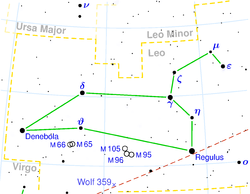
Back Subra AST Subra Catalan HD83809 CE Subra (Stern) German Subra Spanish امیکرون شیر Persian Omicron Leonis French Omicron Leonis ID Omicron Leonis Italian しし座オミクロン星 Japanese
| Observation data Epoch J2000.0 Equinox J2000.0 | |
|---|---|
| Constellation | Leo |
| Right ascension | 09h 41m 09.03s |
| Declination | +09° 53' 32.30" |
| Apparent magnitude (V) | +3.52[1] |
| Characteristics | |
| Spectral type | F8-G0III + A7m[2] |
| U−B color index | 0.21[1] |
| B−V color index | 0.49[1] |
| Astrometry | |
| Proper motion (μ) | RA: -143.20[3] mas/yr Dec.: -37.20[3] mas/yr |
| Parallax (π) | 24.412 ± 0.081 mas[4] |
| Distance | 133.53±0.45 ly (40.96±0.14 pc)[4] |
| Absolute magnitude (MV) | +0.51[5] |
| Orbit[4] | |
| Primary | Aa |
| Companion | Ab |
| Period (P) | 14.498068(6) days |
| Semi-major axis (a) | 0.1834±0.0007 AU |
| Eccentricity (e) | 0.0007±0.0004 |
| Inclination (i) | 57.8±0.2° |
| Longitude of the node (Ω) | 191.6±0.1° |
| Periastron epoch (T) | 2450623.9(9) days |
| Argument of periastron (ω) (secondary) | 214±22° |
| Semi-amplitude (K1) (primary) | 54.75±0.02 km/s |
| Semi-amplitude (K2) (secondary) | 61.66±0.02 km/s |
| Details[4] | |
| ο Leo Aa | |
| Mass | 2.074±0.013 M☉ |
| Radius | 5.73±0.34 R☉ |
| Luminosity | 41.1+5.8 −5.1 L☉ |
| Temperature | 6,107±93 K |
| Metallicity [Fe/H] | 0.11±0.10 dex |
| Age | 800(estimate)[6] Myr |
| ο Leo Ab | |
| Mass | 1.841±0.011 M☉ |
| Radius | 2.43±0.35 R☉ |
| Luminosity | 17.8+5.7 −4.3 L☉ |
| Temperature | 7,600±200 K |
| Metallicity [Fe/H] | 0.11±0.10 dex |
| Other designations | |
| Database references | |
| SIMBAD | data |
Omicron Leonis (ο Leonis, abbreviated Omicron Leo, ο Leo) is a multiple star system in the constellation of Leo, west of Regulus, some 130 light-years from the Sun, where it marks one of the lion's forepaws.
It consists of a binary pair, designated Omicron Leonis A and an optical companion, Omicron Leonis B.[7] A's two components are themselves designated Omicron Leonis Aa (officially named Subra /ˈsuːbrə/, the traditional name for the system)[8][9] and Ab.
- ^ a b c Ducati, J. R. (2002). "VizieR Online Data Catalog: Catalogue of Stellar Photometry in Johnson's 11-color system". CDS/ADC Collection of Electronic Catalogues. 2237: 0. Bibcode:2002yCat.2237....0D.
- ^ Ginestet, N.; Carquillat, J. M. (2002). "Spectral Classification of the Hot Components of a Large Sample of Stars with Composite Spectra, and Implication for the Absolute Magnitudes of the Cool Supergiant Components". The Astrophysical Journal Supplement Series. 143 (2): 513. Bibcode:2002ApJS..143..513G. doi:10.1086/342942.
- ^ a b Van Leeuwen, F. (2007). "Validation of the new Hipparcos reduction". Astronomy and Astrophysics. 474 (2): 653–664. arXiv:0708.1752. Bibcode:2007A&A...474..653V. doi:10.1051/0004-6361:20078357. S2CID 18759600.
- ^ a b c d Gallenne, A.; Mérand, A.; Kervella, P.; Graczyk, D.; Pietrzyński, G.; Gieren, W.; Pilecki, B. (2023-04-01). "The Araucaria project: High-precision orbital parallaxes and masses of binary stars. I. VLTI/GRAVITY observations of ten double-lined spectroscopic binaries". Astronomy and Astrophysics. 672: A119. arXiv:2302.12960. Bibcode:2023A&A...672A.119G. doi:10.1051/0004-6361/202245712. ISSN 0004-6361.
- ^ Anderson, E.; Francis, Ch. (2012), "XHIP: An extended hipparcos compilation", Astronomy Letters, 38 (5): 331, arXiv:1108.4971, Bibcode:2012AstL...38..331A, doi:10.1134/S1063773712050015, S2CID 119257644.
- ^ Hummel, C. A.; Carquillat, J. -M.; Ginestet, N.; Griffin, R. F.; Boden, A. F.; Hajian, A. R.; Mozurkewich, D.; Nordgren, T. E. (2001). "Orbital and Stellar Parameters of Omicron Leonis from Spectroscopy and Interferometry". The Astronomical Journal. 121 (3): 1623. Bibcode:2001AJ....121.1623H. doi:10.1086/319391. S2CID 120280239.
- ^ "Washington Double Star Catalog". United States Naval Observatory. Archived from the original on 14 February 2011. Retrieved 2 January 2018.
- ^ Kunitzsch, Paul; Smart, Tim (2006). A Dictionary of Modern star Names: A Short Guide to 254 Star Names and Their Derivations (2nd rev. ed.). Cambridge, Massachusetts: Sky Pub. ISBN 978-1-931559-44-7.
- ^ "Naming Stars". IAU.org. Retrieved 16 December 2017.
